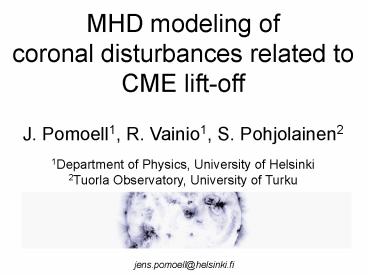MHD modeling of PowerPoint PPT Presentation
1 / 10
Title: MHD modeling of
1
MHD modeling of coronal disturbances related to
CME lift-off J. Pomoell1, R. Vainio1, S.
Pohjolainen2 1Department of Physics, University
of Helsinki 2Tuorla Observatory, University of
Turku
jens.pomoell_at_helsinki.fi
2
Introduction
- Solar flares and coronal mass ejections (CMEs)
capable of launching global large-amplitude
coronal disturbances and shocks - Observed directly in Ha (Moreton waves), EUV (EIT
waves), soft X-rays, He I and radio
STEREO AHEAD EUVI 195 Å May 19, 2007
- Play a role in the acceleration of electrons and
ions to high energies, exact mechanisms unclear - Observed in-situ and as various EM signatures
3
Type II radio bursts
- Plasma emission (FH) caused by shock-accelerated
e- - , knowing
gives
4
Questions Aims
- Current consensus Interplanetary type IIs
generated by CME driven shocks. But what about
coronal type IIs, generated by blast waves
(flares) or driven waves (CMEs)?
or ?
- What about high-frequency type IIs?
- We address such issues by performing MHD
simulations of CME lift-off - Look for features that might be of importance
when interpreting observations
(Pohjolainen, Pomoell, Vainio AA 490, 2008)
5
MHD Model
- 2D model, gravitationally stratified corona
including a dense loop - Superimpose flux rope structure with higher
density
- Alfvén speed increases in the higher corona, low
in the loop
6
Eruption dynamics
Density Speed
- When the flux rope starts to rise, a perturbation
is formed around the flux rope, and steepens to a
shock - Below the loop, the shock remains weak, but
strengthens and slows down quickly when entering
the loop - As the flux rope decelerates, the displaced loop
and shock escape from the driver - The shock escapes quickly after exiting the loop
7
Dynamic spectrum
- Assuming radio type II emission is produced at
the leading edge of the shock, we plot frequency
vs. time
- Qualitative similarities
8
Driven or blast wave?
- In a simulation without dense loops, the shock
also escapes from the flux rope
Density Temperature
- The skirt of the shock sweeps the solar surface
followed by another wave - EIT waves?
9
Summary of results
- Depending on the variations of the Alfvén speed
in the low corona, the erupting CME can at times
acts as the driver of the shock, while at other
times the shock may propagate freely - Difficult to determine whether coronal waves
caused by flare or CME, low-cadence observations
may be misleading - Correlation between speed and location of type II
bursts and ejecta can be very complex - Possible that fragmented, high-frequency type IIs
due to CME driven shocks propagating through
dense coronal loops
10
Conclusion
- By performing numerical simulations side by side
with analysis of observations, the physics
involved in the coronal phenomena can more
readily be extracted than by solely analyzing the
observational data - All approaches needed in order to understand
these dynamical processes

